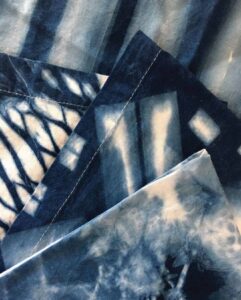
I wanted to share with you one of the most memorable experiences of my creative life.. which has inspired to continue working with Indigo. This was a visit to the Little Indigo Museum outside of Kyoto, Japan in 2015.
Indigo Dyeing with Hirojuki Shindo in Japan

Two trains and two buses. That is what it took for us to get to the magical village of Kita in Miyama, which lies 60 km north of Kyoto, Japan.

The goal; to visit the Little Indigo Museum, and meet Hiroyuki Shindo, a master of Indigo dyeing. He is known in the fiber arts community and has shown his art indigo pieces in numerous major museums throughout the world.
Shindo-san and his family live in Kita, a village composed of amazing thatched-roof dwellings, many of which are more than 200 years old. The Little Indigo Museum’s dwelling is the oldest, and functions not only as a museum, but a workspace, and living quarters.
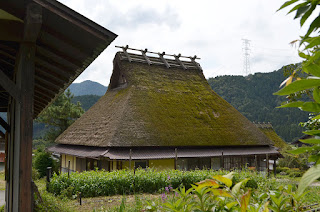 |
| A typical house in the village of Kita |
The Shindo family was most gracious. The museum, in the upstairs of the home held many examples of indigo fabrics, demonstrating dyeing and printing techniques from around the world.
 |
| A view of part of the Indigo Exhibit |
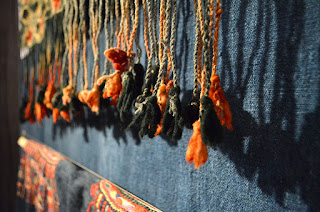 |
| A fringed indigo veil worn by a Berber bride in Tunisa |
 |
| 18th century Indigo print, France |
 |
| Shindo-san cutting hemp for our projects |
The workshop part of our visit allowed us to experience indigo dyeing first-hand. Shindo-san provided each of us with a meter of vintage hemp, and discussed various techniques we could apply using a clamp-resist process.
The first step was to fold the fabric vertically, so as to expose as much of it as possible in the dye bath. Then, we sandwiched the fabric between wood pieces and clamped them in place.
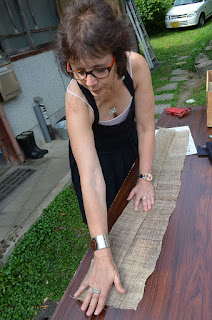 |
| Folding the fabric vertically |
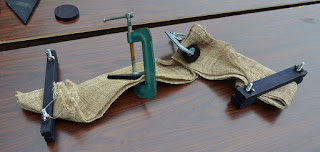 |
| Folding the fabric vertically |
Off to the dye vats!
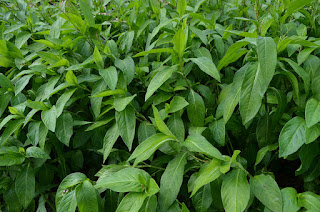 |
| Indigo Plants |
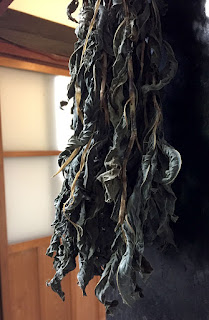 |
| Dried Indigo |
Indigo, as a dye substance, is processed from the leaves of the indigo plant.Here you can see the plants, and leaves once dried, that will be pulverized for use. I was intrigued to learn that a healthy dye bath will be capped with a crowing ‘flower’ formed through a vigorous stirring process, which signifies a healthy ph value.
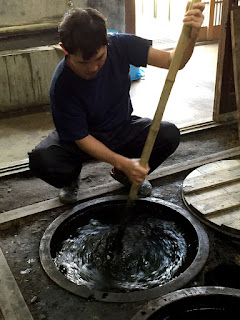 |
| Stirring to create the ‘flower’ |
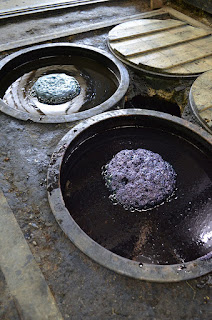 |
| The ‘flower’ |
Don and I decided to use two different techniques. I dipped my cloth completely, and Don space-dyed his, meaning he kept part of his cloth from immersing in the fabric.

The amazing thing about indigo dyeing, is that the bath is a yellowish-green. One doesn’t start to see the blue/navy until oxidation takes place. This can happen through exposure to the air, or through the oxygen in water. Here you can see my fabric as I have unclamped the wood.

Here are our finished pieces; This was too much fun!
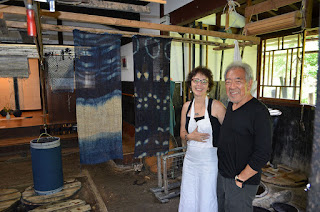 |
| Don’s space-dyed piece (left) and my complete immersed piece (right) |
This visit was one of the highlights of my Japan trip. I cannot thank the Shindo family enough for their generosity in sharing and in spirit.
To learn more about Hirojuki Shindo and his Little Indigo Museum, click on the link below:http://shindo-shindigo.com/
Susan Lazear
Cochenille Design Studio